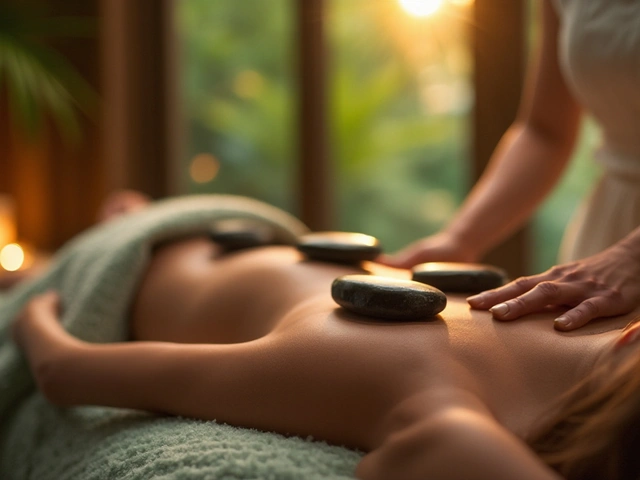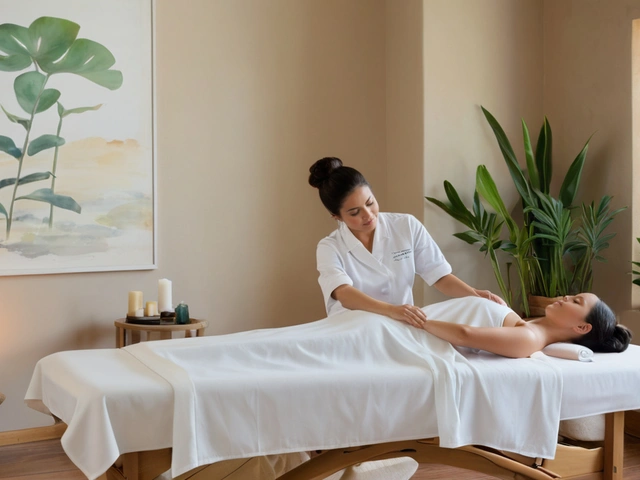The Art and Science of Thai Bodywork: Unlocking Ancient Healing Techniques

Have you ever wondered why Thai bodywork is gaining popularity beyond just spa benefits? It's not just about relaxation – this ancient art comes with a rich history and a host of health benefits. Originating from Thailand over 2,500 years ago, it combines elements of yoga, acupressure, and reflexology, creating a holistic treatment that seeks to balance the mind, body, and spirit.
What makes Thai bodywork distinct is its unique approach to healing. Unlike typical Western massages that focus on muscle relaxation through kneading, Thai bodywork involves guided stretching, rocking, and rhythmic compressions. You're not just lying there while someone works your muscles; you're actively participating, kind of like doing yoga with a little extra help.
Here's something intriguing: did you know that Thai bodywork is often referred to as 'lazy person's yoga'? This isn't to undermine its effectiveness but highlights how it stretches and tones the body without you having to do all the work. Picture it as a yoga class where you're being gently maneuvered into all the right positions.
- Origins and Evolution
- Principles and Techniques
- Health Benefits
- Scientific Insights
- Practical Tips
- Incorporating into Modern Life
Origins and Evolution
Thai bodywork, or what many simply call Thai massage, traces back over 2,500 years and is deeply rooted in the cultures of both India and Thailand. It was inspired by the healing traditions brought to Thailand by Indian Buddhists. There's even a popular belief that one of the Buddha's physicians, Jivaka Komarabhacca, could have been a key figure in its development.
Initially, these techniques were shared in temples, primarily through oral tradition. The main goal was to promote physical health and spiritual harmony among monks and laypeople alike. Unlike Western massages, Thai bodywork wasn't just seen as a luxury practice but rather as an essential therapy for improving health.
The Influence of Buddhism
Buddhism played a pivotal role in shaping Thai bodywork. The techniques were crafted to align with Buddhist teachings, emphasizing compassion, mindfulness, and a non-invasive approach. As Buddhism spread through Southeast Asia, so did these healing practices, evolving with cultural exchanges over the centuries.
Modern-Day Evolution
Jump forward a couple of millennia, and Thai bodywork is more refined yet still deeply traditional. Schools dedicated to teaching these practices popped up in places like Chiang Mai, teaching both locals and tourists worldwide. This evolution is neat; traditional aspects are preserved while modern techniques enhance effectiveness.
A fascinating bit of trivia: Thai bodywork's profound impact on health and wellness led to its recognition by UNESCO as an Intangible Cultural Heritage of Humanity in 2019. Well-deserved, right?
Principles and Techniques
Thai bodywork isn't just your typical massage; it weaves together various healing techniques centered on a basic philosophy: the life force known as 'Sen Energy' flows through pathways in the body. The aim is to balance this energy flow, encouraging the body's natural healing processes.
Core Techniques
Several techniques set Thai bodywork apart from other forms of massage therapy:
- Acupressure: Based on the principles of Chinese medicine, practitioners apply pressure to specific points along the body's energy pathways (Sen lines) to release tension and blockages.
- Stretching: Known as passive yoga stretches, these help in enhancing flexibility and releasing tension. It's like yoga, with a bit of assistance!
- Rhythmic Pressing and Rocking: Practitioners use their palms, elbows, knees, and feet to rhythmically press the body, creating a dynamic dance that deeply relaxes muscles.
The Role of Breath and Mindfulness
Thai bodywork also emphasizes the importance of breath and mindfulness. Let's be real, modern life is stressful! Practitioners often guide the recipient to focus on their breath during the session, fostering a meditative state that enhances the body's relaxation response. This mindful breathing promotes broader self-awareness and a deeper connection with one's body.
Wondering why this matters? Focusing on one's breath can lower cortisol levels, according to several bodywork studies conducted across Asia.
A Dynamic Interaction
In contrast to many massage therapies where the recipient remains passive, Thai bodywork involves active participation. The therapist and recipient engage in a dynamic interaction, creating a flowing routine designed to meet the needs of the individual. This approach makes it adaptable; each session can be tailored to focus on specific areas of discomfort or stress.
And hey, just a heads up: you'll usually be on a floor mat rather than a table. This unique setting allows for more movement and better leverage for the practitioner to work those magic touchpoints.
All in all, these techniques combined with an energy-conscious philosophy make Thai bodywork a powerful holistic therapy, packing a punch of benefits without needing to throw a single one.
Health Benefits
Thai bodywork isn't just about escaping to relaxation paradise. There are real, tangible health benefits that this practice offers. It's like a workout, therapy, and meditation rolled into one neat package.
Improves Flexibility
One of the main benefits is increased flexibility. By engaging in passive yoga-like stretches, your muscles get a gentle yet effective workout. This can help improve your overall range of motion, and let's face it, who doesn't want to feel a bit more limber?
Boosts Circulation
Another perk is enhanced circulation. The rhythmic movement and compressions used in Thai bodywork really get your blood flowing. This isn't just good for your heart – it helps deliver nutrients efficiently throughout your body, promoting better organ function and yes, a natural glow to your skin.
Reduces Stress and Anxiety
- Thai bodywork combines physical therapy with deep breathing techniques, aiding in stress relief.
- The mindful nature can lead to significant reductions in anxiety, offering a calm oasis in your hectic life.
Studies have shown that regular massage therapy can decrease the levels of stress hormones in the body, and Thai bodywork is no exception.
Relieves Pain
Have chronic pain that's bothering you? This ancient technique might just be your answer. By focusing on pressure points, Thai bodywork can alleviate pain from conditions like migraines, backaches, and arthritis. It's like having a reset button for your aches and pains.
Enhances Mental Clarity
Why stop at physical benefits? Many people report clearer thoughts and improved focus post-session. When your body's in tune, your mind tends to follow suit, paving the way for creative and productive days ahead.

Scientific Insights
Ever wondered if there’s real science behind Thai bodywork? Turns out, there's more than just ancient tradition supporting its effectiveness.
One core principle of Thai bodywork is the concept of energy lines, called 'sen'. These are somewhat similar to the meridians in Chinese medicine. The idea is that by applying pressure and stretching along these lines, we can enhance the flow of energy throughout the body.
Research-Backed Benefits
Studies have shown that Thai bodywork can be quite effective in various health aspects. For example, a study from the Journal of Bodywork and Movement Therapies found that participants who received Thai massage reported a significant reduction in pain and stress levels compared to a control group that didn't receive any treatment.
Additionally, evidence suggests that it may aid in improving flexibility and range of motion. A study published in the Journal of Alternative and Complementary Medicine showed that after regular Thai bodywork sessions, participants demonstrated improved flexibility in various joints.
Endorphins and Relaxation
Another interesting scientific insight relates to the release of endorphins during a Thai massage. These are your body's natural painkillers, often referred to as 'feel-good' hormones. The rhythmic flow, rocking movements, and passive stretching involved in Thai bodywork stimulate endorphin production, contributing to relaxed and uplifted feelings.
And there's more! The deep breathing used in these sessions is known to activate the parasympathetic nervous system, which is the body’s natural relaxation system. So, it's not just about the muscles; it's about holistic health.
All in all, it's clear that Thai bodywork isn't just a fad. It's backed by science and continues to gain credibility as an effective form of therapy for a range of conditions.
Practical Tips for Integrating Thai Bodywork
So, you're curious about Thai bodywork and how to make it a part of your wellness routine. Here are some handy tips to get you started on your journey to better health and relaxation.
Finding the Right Practitioner
First things first, choose someone experienced. A practitioner with deep knowledge of Thai bodywork techniques is crucial. Take the time to scrutinize their credentials and maybe even ask for a trial session. Personal recommendations from trusted friends can be a goldmine.
Understanding Your Needs
Your reasons for trying out Thai bodywork can vary. Are you looking to improve flexibility, alleviate pain, or reduce stress? It’s essential to discuss your goals with your practitioner so that the session is tailored to your needs.
Preparing for Your Session
Wear comfortable, stretchy clothing. You're going to be moved around a lot — think of it like going to a yoga class. Also, consider hydrating before and after the session as it may help your body cope with the muscle manipulations.
Regularity is Key
Like any form of wellness practice, consistency is important. Aim to incorporate these sessions into your routine for long-lasting benefits. Some experts suggest starting with weekly sessions and adjusting based on your needs and schedule.
Post-Session Practices
Take some time after your session to relax and allow your body to absorb the treatment. You might also experience enhanced emotional release, which is normal, so don’t forget to allow yourself some space to process it.
DIY Techniques
If regular visits to a practitioner aren't feasible, there are simple techniques you can try at home. Basic stretching and deep breathing exercises inspired by Thai bodywork can be found online. These won't replace a full session, but they can help keep stress levels in check between appointments.
The goal here is not to just tick a box but to genuinely find what works for you and helps you feel balanced. Remember, the key to successful integration is not seeing it as a one-off treat, but as an ongoing investment in your well-being.
Incorporating into Modern Life
Bringing Thai bodywork into everyday life is easier than you might think, and the benefits can be pretty significant. Let's explore how you can make this ancient healing practice a regular part of your routine, helping you to harness its full potential.
Starting with The Basics
If you're a newbie, it's best to begin with a professional session. Many spas and wellness centers offer Thai bodywork, so search for one with experienced practitioners. This way, you can ensure that your initial experience is authentic and effective.
For those curious about trying it at home, learning basic stretches and moves can be incredibly rewarding. Resources like online videos or classes can guide you in practicing the foundational techniques safely.
Creating a Routine
Incorporating Thai bodywork doesn't mean you need to book appointments every week. Instead, focus on how often you want or need to engage with it. A good starting point might be once a month if you're busy, with some simple stretches at home between sessions.
- Begin with short daily routines, perhaps 10-15 minutes in the morning.
- Set aside a relaxed space at home where you won't be interrupted.
- Combine it with meditation or mindful breathing for added mental benefits.
Integrating with Other Wellness Practices
One neat thing about Thai bodywork is how well it pairs with other wellness practices. Combining it with regular yoga classes, meditation, or even a balanced diet can create a holistic lifestyle approach.
Embracing Technology
In today's digital age, apps and online platforms make accessing Thai bodywork techniques easier. From guided sessions to interactive workshops, there's a wealth of information waiting at your fingertips.
By integrating Thai bodywork into your modern life, you’re not just adopting a fitness regimen. You’re embracing a holistic way to improve your physical and emotional health, all while taking a break from the hustle and bustle of daily life. Give it a try – your body and mind might just thank you!





